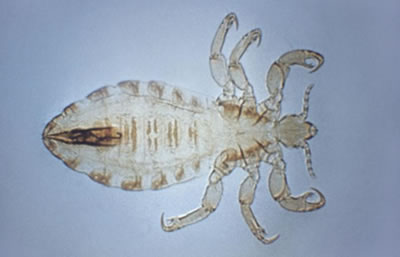Lice
Lice are small, wingless insects that attach
themselves to the hair shafts of the head, body, and pubic area.
These insects feed on blood and lay their eggs called nits
on the hair shaft.

Body louse (pl. lice) or Pediculus humanus
corporis.
Symptoms of Lice Infection
Lice infection symptoms include:
- Black mites
- White flakes (eggs or nits)
These eggs oval in shape, pinhead-sized and white or gray in
color. They are often mistaken for dandruff - however, unlike
dandruff, they are firmly attached to the hair shaft.
- Itching
A secondary bacterial infection may develop on the skin that
is injured by repeated scratching.
Who Gets Lice?
Pubic lice (also known as crab lice
or crabs) are spread through sexual contact.
Head lice is common in young children, and is
very contagious. It spreads through:
- Direct contact
- Shared clothings and hats
- Shared combs and brush
How can it be prevented?
Body lice can be prevented by good hygiene and
regular bathing
Head lice can be prevented by encouraging children not to share
clothings, hats, combs, brush, or anything else that can transfer
the mites and eggs.
Treatment of Lice Infection
Lice can be treated by:
- Nonprescription antilice shampoo, lotions and creams
These products usually contain pyrethrins or permethrin.
- Physical removal of the eggs using special combs or tweezers.
- Hydrocortisone lotion for the itching
As the mite eggs can survive in clothings, it is crucial to wash
and dry clothings, bedsheets and blankets in a hot dryer.


